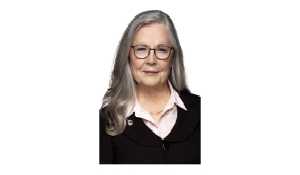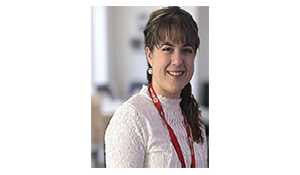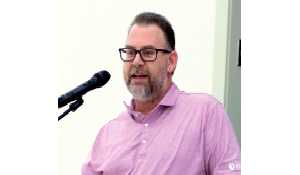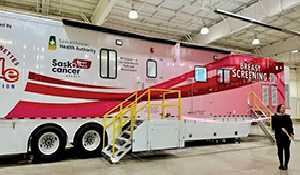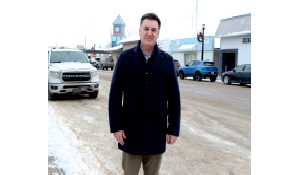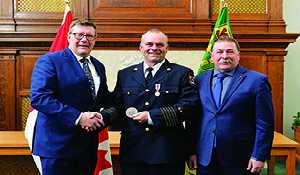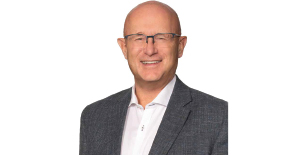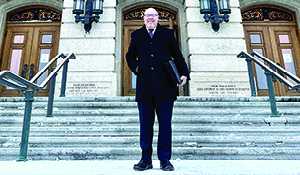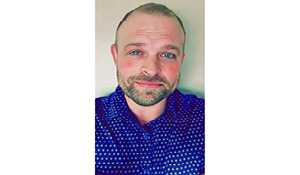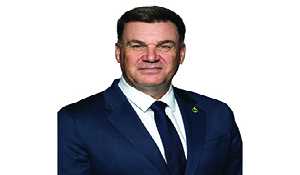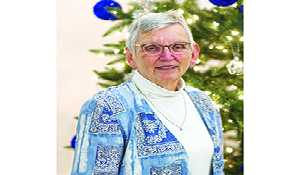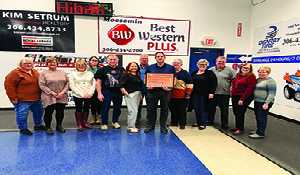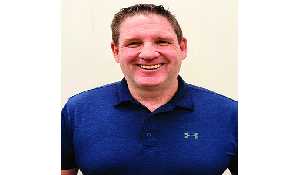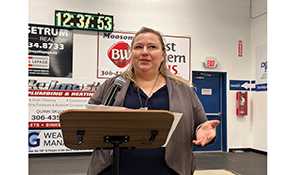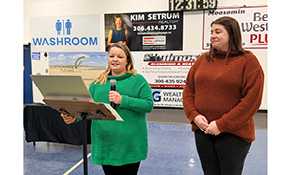Bryce Eger leading Corteva Canada
From Moosomin, Sask to Canadian head of a global agribusiness
June 21, 2019, 4:09 am
Kevin Weedmark
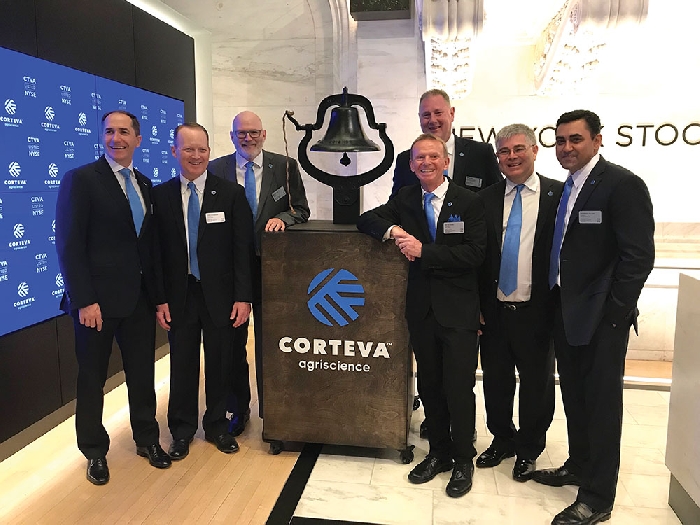

Bryce Eger, originally from Moosomin, was on the floor of the New York Stock Exchange Monday, June 1 as officials of Corteva rang the opening bell to mark the start of trading on the NYSE that day, the first day Corteva shares were trading.
Corteva is a new company created from Dow Agrosciences, DuPont Crop Protection and Pioneer.
Eger is Canadian president of Corteva. The World-Spectator interviewed Eger last week about his role in the company and about being part of a new company with $14 billion in annual sales.
Tell me about the experience at the NYSE and how the event at the New York Stock Exchange came about?
We started by merging Dow and DuPont back in September of 2017. That was the two major organizations that merged together, always knowing that we were going to split that merged company into three, and knowing Corteva was going to be the ag business that was going to be split out, so we worked over the last year and half to get the organizations ready to do that.
Our date of making that separation was June 1 and we worked to get the company stood up within the company, so that we were operating within the parent organization of DowDuPont and then got ready to spread our wings and fly, which happened last week on June 1.
We were going to be a brand new publicly traded company on the New York Stock Exchange, and of course when you are a new company that is traded on the stock exchange like Corteva, you get the opportunity to get engaged with the stock exchange on a different level, and so they had given us the opportunity to ring the opening bell and have a bit of a celebration that went with it as we came on as CTVA—our official stock symbol. That was really the culmination of a couple years of hard work to get us ready to actually be a stand alone ag business.
Was it you and quite a few of your colleagues there for the opening bell?
There were approximately 90 people in New York for the event. At the stock exchange that day there were approximately 20 employees and then there were six farmers from around the world. We have six regions as a company globally and there was one from each one of those regions. So we had a Canadian customer who was there. And we had media from around the world there as well, so there were just under 20 media outlets that were there as part of the event as well.
With Corteva being independent now, does it make much difference in how you operate? What difference will your farming customers see?
It really does, Kevin. Everybody that works for Corteva, from our senior executives through the organization, our summer students that come to work for us, everybody that now that works for Corteva, thinks about agriculture and thinks about the farmer and thinks about the consumer —so the folks that are eating the food, and the products that we are producing on the land.
That is a fundamental difference because with the other organizations, the ag businesses were part of a conglomerate that was built to ride out various economic storms that may happen across various industries.
Now we have everybody in the organization that has been thinking about agriculture, and that is fundamentally different. When we are thinking about spending capital dollars on investment and investing back in the business, it’s not a discussion around whether or not it’s going to go to an alternate industry or go to a business other than our own. It really is just what’s going to be most beneficial to our farmer customers and what’s going to be most beneficial to what we are doing as an organization, which is 100 per cent focused on agriculture.
That’s very different from being part of a conglomerate where at any given time the cell phone market might be the hottest industry of the day and the resources go to research and development in that segment, whereas now it’s just about which part of the world has the biggest opportunity where we can make the biggest difference, so very, very different.
How big of a company is Corteva? What would your annual sales be?
Our annual sales are somewhere around $14.5 billion U.S. and our EBITA earnings are $2.2-2.3 billion.
What’s your role in the company?
I’m the president of Corteva AgriScience Canada, so I have responsibility for the commercial organization in Canada, as well as oversight over the functional business. So the legal entities, the operating companies that we have in Canada—I’m the president of all of them.
Tell me a little bit about your background and your career.
I started out of university with Cargill. So I started out in the grain business out of university and had a number of different roles, and got a chance to work in country grain operations in sales and marketing, grain merchandising and back into sales leadership, and then into general management and a few stops in between in my just about 15 years with Cargill. So I did a lot of different things and moved around the country a fair bit and had an opportunity to experience all parts of agriculture in Canada, from Western Canadian, prairie agriculture, broadacre agriculture, right down to being engaged in the corn and soybean business and dairy business in Ontario and Quebec and the Maritimes as well as being involved in the horticulture business and the greenhouse business with products that we were selling into those markets as well.
I got a really, really cool experience working for Cargill, and then ten years ago I came to work for a Pioneer Hybrid, which was the seed division of DuPont Agriculture or DuPont Canada. I went there as the national sales manager. So I was leading the sales organization for Pioneer Hybrid and then had an opportunity to take on a general management role in eastern Canada, so had everything that was involved in operations, marketing, sales, research and development and had oversight over that for eastern Canada. And then a couple years later after I’d done that, I had the opportunity to take on a seed production supply chain role. So I had the seed production supply chain operations for Canada. That was our corn, soy bean and canola production facilities, as well as I had a chance to lead the Woodland California Global Sunflower production facility as well. I got experience in producing seed not only in Canada and across Canada, but also in California, and 90 per cent of what we produced at that plant in California actually went to Europe, so got a chance to work with our European counterparts.
After a couple years of that, the former president of Pioneer Hybrid retired and they asked if I could take over as the president of the Pioneer Hybrid business in Canada. And a few short months after, they asked if I would also lead the DuPont Crop Production business and bring the seed business and crop production business together for DuPont in Canada. I did that, and very quickly, within a few months of that, the merger was announced between Dow and DuPont. It took us a year and a half to get to the point where the merger took place, but then with the announcement of the merger, I was asked if I would lead the combined ag business in Canada for Corteva as well. So I’ve been doing this role effectively for two years now.
Has your career taken a path that you would have expected when you were in university?
The path has been similar. I knew when I was in university that I definitely enjoyed finance and business and economics. My degree was in economics, so I did really enjoy understanding trends and working with numbers, but what I found more enjoyable in university was when I got a chance to work through group projects and work with people to achieve a result. So I had an idea that I wanted to get into business. I didn’t know it was going to be into the ag business, quite honestly.
You know my mom and dad, they’re not farm people. My aunt and uncle were the farmers in our family, and I got a great experience growing up, going out to see their farm a lot, but I didn’t really think farming was necessarily where I was going to land.
In fact my mom thought I was kidding when I said I was going to go work for Cargill. She thought I was just joking. I was like ‘no, I want to go do this because it’s something that I didn’t really think about when I was at university.’
Getting into ag was really good because I knew the people were genuine.
Growing up in Moosomin with all the farmers that are around town, and friends that farm and family that farm, I knew that I was going into an industry where people are pretty pleasant and pretty genuine and overall good to deal with.
What I didn’t realize is the size and scale. Until I got involved in agriculture I didn’t realize how much was going on on any of the farms around Moosomin, around the area.
A few months into my career I realized that I really, really did enjoy sales, so I enjoyed being front and center with a customer and helping solve problems, but I also really, really enjoyed meeting people, and I got a chance to lead people very early in my career.
Within the first year I had folks that were reporting to me, so that was a really great experience because it set me on a path of getting things done through others. Working with others to get the most out of their careers for them was really what I wanted to be able to do.
The trajectory has maybe been a little faster than what I expected. I have been lucky and have been given opportunities to take on more and more responsibility and accountability relatively early in my career. I would say that is a hallmark of Cargill. Cargill was very, very good—if you were willing to put your hand up and willing to own up to your mistakes when you made them, Cargill was willing to give you the opportunity, and I was lucky because I had that experience at Cargill, and from there it’s been continuing to refine and learn. Every day I get the opportunity to learn something, and that of course has brought the experience of getting to this point where I get to lead the Canadian business for Corteva.
How has the process gone for spinning Corteva out—is it a very complicated process to spin it out as a separate company? What have been the challenges along the way?
Yes it’s been complicated. I would say that what we thought we were doing at the start changed along the way. It’s kind of like 4-H because you learn to do by doing. There was lots of support, but there really hadn’t been a lot of experience with something similar to what we were doing.
We were merging two very large organizations knowing full well that the very next day, once we had consummated, then we were actually going to split into three.
Literally the day after we merge, the work to start splitting apart the organization—from the people, the processes, the systems—all started.
It was very complex because a lot of the back office functional work that was taking place was across a conglomerate business, and so it took a tremendous amount of effort from our functional teams, our IT teams, our health and safety teams, our finance and controllership teams, to be able to actually separate out the work that was being done and how it was going to be orchestrated when we spun out.
We’re a startup business that has a couple hundred years worth of experience, but that couple hundred years of experience didn’t necessarily set us up to just flick the switch and spin out. The experience was around how we work with farmers and what we did in agriculture, it wasn’t necessarily what was going on in the back office, which is as important. When you’re spinning your organization, you’re just getting your product and your price and your commercial and sales part of the organization aligned. The stuff that happens behind the scenes is very important and I could say that is where a lot of our energy went, and a lot of the extra work that wasn’t planned went into.
At this point, is everything working exactly the way you want and the organization is in the shape you want to move forward, or is there still some effort to merge the corporate cultures and have Corteva operating exactly the way you would want?
There is always room to improve. When I look at our organization and how much change we have thrown at the infrastructure, the people, I’m very, very happy with what we’ve come through and how far we’ve come in a short period of time.
The opportunity is to get us to function as that start up and to function as Corteva as a stand alone organization, which is very unique to the cultures to a certain extent of the legacy organizations that made us up. We had three parts that really made up Corteva Pioneer Hybrid Seed business, which was a stand alone company that DuPont had bought back in the late ‘90s. We had the DuPont Crop Production Business, which was part of the greater DuPont, that was focused on herbicide, fungicide technology for agricultural chemistry primarily, and then they had the Dow Agri Sciences business which was a consolidated business, a smaller seed business and a little bit more robust crop protection business.
Each one of those three businesses had somewhat unique cultures, and what we had to do was figure out is how do we bring all that together and how do we create new, because there are lots of great cultural parts each of those businesses brought to the table, but in order to really be Corteva, we have to be able to create that new culture, focusing on where we’re going to spend our energy.
Focusing on the consumer is an example, having a purpose statement such as what we have, to enrich the lives to those who produce and those who consume, ensuring progress for generations to come is a place for all of the members of the organization to come together and say this is different, this is not just about the farmer, it’s also about the consumer, it’s also about leading things better each successive year and generationally, doing better for the farmer and the consumer.
Culturally that is different than what the legacy organizations stood for, and so finding those spots that we can actually bring people together and have them think differently culturally—that has been very important over the course of the first year and a half prior to spin. Now we need to accelerate it because now it’s just us.
What are your immediate goals right now? What do you want to accomplish for Corteva and for yourself over the next year or two?
One of the first things we wanted to do this year was spin the company. We’ve got that done. The second thing is embed deeply in the organization the behaviors that align to our purpose. As an example, we really do want to make sure that we’re focused on championing the customer success, farmer success and consumer needs and bringing that together.
If I were to look back two years from now, to give us a checkmark for something as specific as that, we would have to make sure that our farmer customers, our retail partners that we do business with, that they gave us that checkmark and they said ‘you brought together this organization and we’re better off because of it that.’ We also want to make sure that the consumers that are purchasing food products from the technologies that we have become more comfortable with where the technology is going and the science that goes into it as well as the safety that comes with that.
We do want to make sure that we partner with society. That’s another one of the behaviors that we’ve asked the team to embrace, which is that we’re trusted. So two years from now if somebody from the U of S wants to have a keynote speaker about modern agriculture, I want us to be the first choice. I want somebody on our team to be the first choice to come and speak to new students or speak of behalf of the academics about taking the science of modern agriculture and putting it into practice and making that relatable for consumers and society.
Another thing we want to make sure we do really, really well is, we know that we have to look outside of ourselves. In order to meet the needs of those consumers and our farmer customers, the world is a really small place now, and so we have to be looking to outside partnerships to make sure that the products we’re bringing to the market are really doing what we need and what our customers need them to do.
One area that is really important is when we think of the consumer and we hold that up as something that we want to aspire to do and be—to be connected to the consumer—we need to look to outside organizations to learn from that. Two years into the future I would want us to be considering that we have brought in ideas, talent, processes from other companies from around the world and other industries to make sure that we really are living that purpose statement around enriching the lives of those who produce and those who consume.
That is the journey we are on in the next two years, and there’s a lot of work and we’ve got a lot of lifting to do to get there, so lots to be done.
What are your own long-term goals?
My long term goal is to continue to have an opportunity to serve a team of people. I really do believe that my role as a leader in this organization is to continue to do that.
When I look out a few years, being able to continue to have a role where I can work across an organization and work very closely with members of the team, coaching them, and helping develop their talent so that they then will take over for me when I’m ready to go and do something else, that is ultimately what I want to do.
I don’t have aspirations to be our CEO. That’s not in my mindset at this point. Jim Collins is our CEO. He is a wonderful, wonderful man, but I don’t see myself wanting to be in that position. I need to roll up my sleeves a little bit and relate to the farmers we get to do business with and help our next generation of employees become even better. That is what I really want to be able to do with my career.
For someone with economics training, it must have been exciting to be right at the New York Stock Exchange.
It’s a little bit different than it used to be.
There still is a very, very tremendous amount of nervous energy and build up and you can feel the energy in the room, but it’s all being done electronically, so it’s being done by a broker sitting at multiple computer terminals.
Most of them have four to eight computer terminals that are in front of them and they are watching different markets and different stocks at the same time, but there is just this unbelievable amount on energy—the commerce of the world coming together—and of course a lot of activity around what’s going on and what’s trading and what the Dow Jones Industrial Average is for example, how it’s trading over the day.
There was just a tremendous amount of energy felt on the floor for sure.
